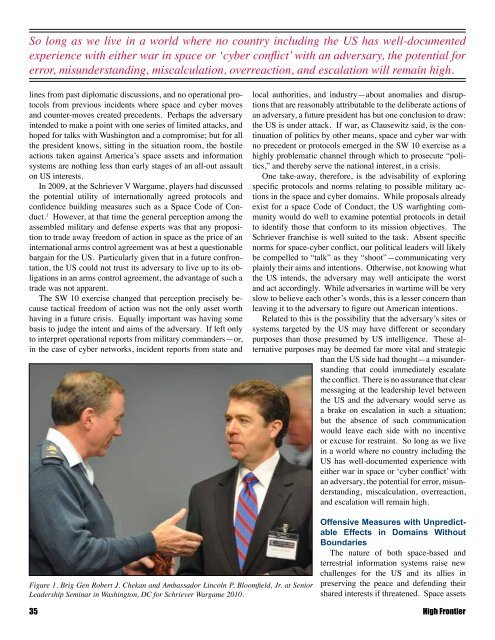Schriever Wargame 2010 - Air Force Space Command
Schriever Wargame 2010 - Air Force Space Command
Schriever Wargame 2010 - Air Force Space Command
Create successful ePaper yourself
Turn your PDF publications into a flip-book with our unique Google optimized e-Paper software.
So long as we live in a world where no country including the US has well-documented<br />
experience with either war in space or ‘cyber conflict’ with an adversary, the potential for<br />
error, misunderstanding, miscalculation, overreaction, and escalation will remain high.<br />
lines from past diplomatic discussions, and no operational protocols<br />
from previous incidents where space and cyber moves<br />
and counter-moves created precedents. Perhaps the adversary<br />
intended to make a point with one series of limited attacks, and<br />
hoped for talks with Washington and a compromise; but for all<br />
the president knows, sitting in the situation room, the hostile<br />
actions taken against America’s space assets and information<br />
systems are nothing less than early stages of an all-out assault<br />
on US interests.<br />
In 2009, at the <strong>Schriever</strong> V <strong>Wargame</strong>, players had discussed<br />
the potential utility of internationally agreed protocols and<br />
confidence building measures such as a <strong>Space</strong> Code of Conduct.<br />
1 However, at that time the general perception among the<br />
assembled military and defense experts was that any proposition<br />
to trade away freedom of action in space as the price of an<br />
international arms control agreement was at best a questionable<br />
bargain for the US. Particularly given that in a future confrontation,<br />
the US could not trust its adversary to live up to its obligations<br />
in an arms control agreement, the advantage of such a<br />
trade was not apparent.<br />
The SW 10 exercise changed that perception precisely because<br />
tactical freedom of action was not the only asset worth<br />
having in a future crisis. Equally important was having some<br />
basis to judge the intent and aims of the adversary. If left only<br />
to interpret operational reports from military commanders—or,<br />
in the case of cyber networks, incident reports from state and<br />
local authorities, and industry—about anomalies and disruptions<br />
that are reasonably attributable to the deliberate actions of<br />
an adversary, a future president has but one conclusion to draw:<br />
the US is under attack. If war, as Clausewitz said, is the continuation<br />
of politics by other means, space and cyber war with<br />
no precedent or protocols emerged in the SW 10 exercise as a<br />
highly problematic channel through which to prosecute “politics,”<br />
and thereby serve the national interest, in a crisis.<br />
One take-away, therefore, is the advisability of exploring<br />
specific protocols and norms relating to possible military actions<br />
in the space and cyber domains. While proposals already<br />
exist for a space Code of Conduct, the US warfighting community<br />
would do well to examine potential protocols in detail<br />
to identify those that conform to its mission objectives. The<br />
<strong>Schriever</strong> franchise is well suited to the task. Absent specific<br />
norms for space-cyber conflict, our political leaders will likely<br />
be compelled to “talk” as they “shoot”—communicating very<br />
plainly their aims and intentions. Otherwise, not knowing what<br />
the US intends, the adversary may well anticipate the worst<br />
and act accordingly. While adversaries in wartime will be very<br />
slow to believe each other’s words, this is a lesser concern than<br />
leaving it to the adversary to figure out American intentions.<br />
Related to this is the possibility that the adversary’s sites or<br />
systems targeted by the US may have different or secondary<br />
purposes than those presumed by US intelligence. These alternative<br />
purposes may be deemed far more vital and strategic<br />
than the US side had thought—a misunderstanding<br />
that could immediately escalate<br />
the conflict. There is no assurance that clear<br />
messaging at the leadership level between<br />
the US and the adversary would serve as<br />
a brake on escalation in such a situation;<br />
but the absence of such communication<br />
would leave each side with no incentive<br />
or excuse for restraint. So long as we live<br />
in a world where no country including the<br />
US has well-documented experience with<br />
either war in space or ‘cyber conflict’ with<br />
an adversary, the potential for error, misunderstanding,<br />
miscalculation, overreaction,<br />
and escalation will remain high.<br />
Figure 1. Brig Gen Robert J. Chekan and Ambassador Lincoln P. Bloomfield, Jr. at Senior<br />
Leadership Seminar in Washington, DC for <strong>Schriever</strong> <strong>Wargame</strong> <strong>2010</strong>.<br />
Offensive Measures with Unpredictable<br />
Effects in Domains Without<br />
Boundaries<br />
The nature of both space-based and<br />
terrestrial information systems raise new<br />
challenges for the US and its allies in<br />
preserving the peace and defending their<br />
shared interests if threatened. <strong>Space</strong> assets<br />
35 High Frontier

















